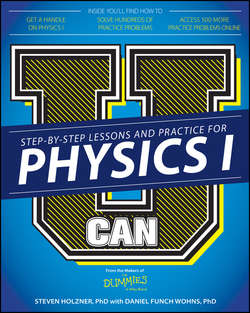Читать книгу U Can: Physics I For Dummies - Steven Holzner - Страница 11
На сайте Литреса книга снята с продажи.
Part I
Chapter 2
Reviewing Physics Measurement and Math Fundamentals
Eliminating Some Zeros: Using Scientific Notation
ОглавлениеPhysicists have a way of getting their minds into the darndest places, and those places often involve really big or really small numbers. Physics has a way of dealing with very large and very small numbers; to help reduce clutter and make them easier to digest, it uses scientific notation.
Remember: In scientific notation, you write a number as a decimal (with only one digit before the decimal point) multiplied by a power of ten. The power of ten (10 with an exponent) expresses the number of zeroes. To get the right power of ten for a vary large number, count all the places in front of the decimal point, from right to left, up to the place just to the right of the first digit (you don’t include the first digit because you leave it in front of the decimal point in the result).
For example, say you’re dealing with the average distance between the sun and Pluto, which is about 5,890,000,000,000 meters. You have a lot of meters on your hands, accompanied by a lot of zeroes. You can write the distance between the sun and Pluto as follows:
The exponent is 12 because you count 12 places between the end of 5,890,000,000,000 (where a decimal would appear in the whole number) and the decimal’s new place after the 5.
Scientific notation also works for very small numbers, such as the one that follows, where the power of ten is negative. You count the number of places, moving left to right, from the decimal point to just after the first nonzero digit (again leaving the result with just one digit in front of the decimal):
Remember: If the number you’re working with is larger than ten, you have a positive exponent in scientific notation; if it’s smaller than one, you have a negative exponent. As you can see, handling super large or super small numbers with scientific notation is easier than writing them all out, which is why calculators come with this kind of functionality already built in.
Using unit prefixes
Scientists have come up with a handy notation that helps take care of variables that have very large or very small values in their standard units. Say you’re measuring the thickness of a human hair and find it to be 0.00002 meters thick. You could use scientific notation to write this as meters ( meters), or you could use the unit prefix , which stands for micro: . When you put in front of any unit, it represents 10– 6 times that unit.
A more familiar unit prefix is k, as in kilo, which represents 103 times the unit. For example the kilometer, km, is 103 meters, which equals 1,000 meters. The following table shows other common unit prefixes that you may see.
Examples
Q. How does the number 1,000 look in scientific notation?
A. The correct answer is 1.0 × 103. You have to move the decimal point three times to the left to get 1.0.
Q. What is 0.000037 in scientific notation?
A. The correct answer is 3.7 × 10– 5. You have to move the decimal point five times to the right to get 3.7.
Practice Questions
1. What is 0.0043 in scientific notation?
2. What is 430,000 in scientific notation?
3. What is 0.00000056 in scientific notation?
4. What is 6,700 in scientific notation?
Practice Answers
1. 4.3 × 10– 3. You have to move the decimal point three places to the right.
2. 4.3 × 105. You have to move the decimal point five places to the left.
3. 5.6 × 10– 7. You have to move the decimal point seven places to the right.
4. 6.7 × 103. You have to move the decimal point three places to the left.
